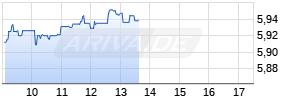| DGAP-Ad-hoc: BP p.l.c. / Key word(s): Miscellaneous BP p.l.c.: bp update on strategic progress 08-Feb-2022 / 08:30 CET/CEST Disclosure of an inside information acc. to Article 17 MAR of the Regulation (EU) No 596/2014, transmitted by DGAP - a service of EQS Group AG. The issuer is solely responsible for the content of this announcement. press release 8 February 2022 bp update on strategic progress Transformation to Integrated Energy Company on track, aims to grow earnings through 2030 and accelerate net zero ambition
bp today reports its full year results for 2021 and will also give an update on its strategic transformation, including accelerating its net zero ambition. The strong progress bp has made over the past few years has reinforced its confidence in the delivery of its earnings and returns targets for 2025. In addition, it is now aiming to continue to grow EBITDA through to 2030. bp is now aiming to sustain earnings (EBITDA) from resilient hydrocarbons out to 20301, despite focusing its oil and gas production and refining throughput. bp also expects to increase the proportion of its capital expenditure in transition growth businesses to more than 40% by 2025 and is aiming for around 50% by 2030. It aims to generate earnings of $9-10 billion from these businesses by 20302, driven by five transition growth engines - bioenergy, convenience, electric vehicle (EV) charging, renewables and hydrogen. Bernard Looney, bp chief executive, said: "Over the past two years we have set a new purpose, direction and strategy for bp, and completed the largest re-organisation in our history. With this period of change fully behind us, we are now solely focused on driving value through the safe, efficient delivery of our strategy. "We enter 2022 with growing confidence. The past two years have reinforced our belief in the opportunities that the energy transition presents - to create value for our shareholders and to get to net zero. The need for, and role of, an integrated energy company (IEC) has - to our minds - never been clearer. Underpinning all of this is our steadfast commitment to perform while transforming." Disciplined strategic progress Since setting out its strategy in August 2020, bp has made strong progress across each of its three strategic focus areas and is on track to meet the targets it set for 2025.
bp now expects to sustain EBITDA from resilient hydrocarbons at around $33 billion a year to 2025 and aims to maintain it in a $30-35 billion range to 20301, even while oil and gas production is expected to decline 40% from 2019 levels by 2030. bp plans to deliver this through a continued focus on costs and performance, and disciplined investment in high margin opportunities, while also continuing to focus and high-grade its portfolio. As the world seeks lower carbon fuels, bp sees clear opportunities to leverage its portfolio of assets and customer base - hence bioenergy is one of bp's transition growth engines. This includes biofuels, including sustainable aviation fuel, and biogas. Building on its refinery footprint, bp anticipates investing in five major biofuels projects, including the conversion of up to two refineries. It also sees opportunity for considerable growth in biogas in the US, Europe and UK.
bp remains on track with its aim to double 2019 earnings from convenience & mobility to $9-10 billion in 2030, with both convenience and EV charging as transition growth engines. bp has 2,150 strategic convenience sites worldwide and has now increased its aim for 2030 to around 3,500. bp has also increased its aim for charging points to more than 100,000 by 2030. With a focus on fast and on-the-go charging - almost half bp's current network is fast or ultra-fast - and on fleets, bp is aiming to increase the energy sold across its EV charging networks 100-fold from 2019 to 2030.
With disciplined annual capital expenditure in low carbon energy planned to grow to $3-5 billion by 2025 and $4-6 billion by 2030, bp is aiming for EBITDA of $2-3 billion by 2030. bp sees both renewables and hydrogen as transition growth engines. With its renewables pipeline and 4.4GW developed to FID at end-2021, it is on track for its target of having developed 20GW renewable power capacity by 2025 and its aim for 50GW by 2030. bp remains confident of achieving 8-10% levered returns for these investments. In hydrogen, bp has built a significant portfolio of options in advantaged markets worldwide with potential capacity of 0.7-1.3 million tonnes a year. These also enable additional value creation through integration with renewables and CCS. bp investing in Britain In delivering its strategy, bp expects to show how operating as an integrated energy company can create value while supporting the low carbon ambitions of cities, countries and regions. This is demonstrated by its plans in its home in the UK, where it expects to invest across all its transition growth engines. bp anticipates spending more than double the profit it generates in the UK out to the middle of this decade. Its plans represent an important return to growth for bp and its investment in the UK. bp helped to create hydrocarbon value chains in the UK - in the North Sea, retail and convenience, and supply and trading - and now intends to help lead the creation of new electron and hydrogen value chains. Bernard Looney commented: "Britain has been our home for more than 110 years and we are excited to help as it transitions to a thriving net zero economy." bp's plans in the UK include:
This approach is not limited to the UK - bp sees opportunities to apply this integrated energy company model in many other geographies around the world. Accelerating net zero ambition The strategic progress bp is making, and the growing confidence it has in the opportunities of the energy transition, is now also allowing it to accelerate its net zero ambition and aims. Bernard Looney said: "We are accelerating the greening of bp. Our confidence is growing in the opportunities that the energy transition offers. This allows us to raise our low carbon ambitions, and we are now aiming to be net zero across operations, production and sales by 2050 or sooner - unique among our peers. In a world heading for net zero, we're best positioned for success if we are also heading for net zero. We believe our ambition is both good business and supports society's drive towards the Paris goals."
bp intends to provide shareholders with the opportunity of an advisory vote on its net zero ambition at its 2022 AGM. Growing earnings and distributions Continuing to deliver this strategy is expected to allow bp to meet its 2025 targets of: - growing EBIDA per share at a 7-9% CAGR to 20253; - growing ROACE to 12-14% by 20254; and - growing the proportion of capital employed in transition growth businesses to over 20%, and the proportion of capital investment allocated to them to over 40%, by 2025. With a continuing commitment to its financial frame, including strict capital discipline, bp believes that - at an oil price of around $60 per barrel and subject to board discretion - it has the capacity to increase its dividend per ordinary share by around 4% a year through 2025. In addition, with its commitment to returning at least 60% of surplus cash flow through share buybacks - subject to retaining a strong investment grade credit rating - bp also expects to deliver around $4 billion buybacks a year at $60 a barrel through to 2025 - with upside in higher price environments. Together with the strategy this underpins confidence in bp's investor proposition to deliver long-term value to shareholders through committed distributions, profitable growth and sustainable value. bp's fourth quarter and full year 2021 results can be seen here: https://www.bp.com/en/global/corporate/news-and-insights/press-releases/fourth-quarter-2021-results.html Further information: bp press office, London, bppress@bp.com +44 (0)7831 095541 Footnotes: 1 at $60/bbl Brent (2020, real) and $3/mmbtu Henry Hub (2020, real), RMM $12/bbl (2020, real). Includes Rosneft and trading. 2 at $60/bbl Brent (2020, real) and bp planning assumptions. 3 between 2H19/1H20 and 2025, at oil prices of $50-60 per barrel in 2020 real terms and bp planning assumptions. 4 at oil prices of $50-60 per barrel in 2020 real terms and bp planning assumptions. Definitions: For the purposes of this announcement, each of the following terms has the meaning given to it in bp's fourth quarter and full year 2021 financial results announcement: adjusting items; EV charge points; renewables pipeline / renewables development pipeline; major projects; upstream; developed renewables to final investment decision (FID); and surplus cash flow. For the purposes of this announcement, each of the following terms has the meaning given to it in the bp Annual Report and Form 20-F 2020: capital expenditure; margin share for convenience and electrification; return on average capital employed (ROACE); and strategic convenience sites.
Cautionary statement In order to utilize the 'safe harbor' provisions of the United States Private Securities Litigation Reform Act of 1995 (the 'PSLRA') and the general doctrine of cautionary statements, bp is providing the following cautionary statement: The discussion in this announcement contains certain forecasts, projections and forward-looking statements - that is, statements related to future, not past events and circumstances - with respect to the financial condition, results of operations and businesses of bp and certain of the plans and objectives of bp with respect to these items. These statements may generally, but not always, be identified by the use of words such as 'will', 'expects', 'is expected to', 'aims', 'should', 'may', 'objective', 'is likely to', 'intends', 'believes', 'anticipates', 'plans', 'we see', 'focus on' or similar expressions. In particular, the following, among other statements, are all forward looking in nature: plans and expectations regarding bp's performance, earnings, returns, capital expenditure, targets, aims and market position through 2025 and/or 2030 at the group, segment and business level, including with respect to bp's resilient hydrocarbons, convenience and mobility and low carbon energy businesses; plans and expectations related to bp's 2025 targets of growing EBIDA per share at 7-9% CAGR through 2025, growing ROACE to 12-14% by 2025, and growing proportion of capital investment in transition growth businesses to over 40% by 2025; plans, expectations and assumptions regarding oil and gas demand, supply or prices, storage, the timing of production of reserves; plans and expectations regarding capital expenditure dedicated to bp's transition businesses; expectations regarding bp's earnings from transition businesses, including the aim to generate $9-10 billion from transition businesses by 2030, and the drivers thereof; plans and expectations regarding investments in new projects, including biofuels, hydrogen and CCS projects; plans to high grade bp's oil and gas portfolio, as well as plans and expectations related to costs and margins in bp's resilient hydrocarbons business; plans and expectations related to the growth of convenience sites, EV charging points and energy sold across bp's networks by 2030; plans and expectations in renewables to develop 20 gigawatts of power capacity by 2025 and 50 gigawatts by 2030; plans and expectations regarding bp's five growth engines of biofuels, convenience, EV charging, renewable power and hydrogen, including plans and expectations related to allocation of capital expenditure and their levered returns and EBITDA growth; plans and expectations regarding bp's potential capacity in hydrogen; plans and expectations regarding bp's investment in the UK, including plans to spend more than double the profit bp generates in the UK out to the middle of this decade and potentially longer, plans to develop offshore wind, solar power, hydrogen and CCUS projects in the UK and plans to grow bp's EV charging and convenience offers; plans and expectations regarding bp's net zero ambitions and aims, including targets related to reduction of operational and lifecycle emissions and carbon intensity of bp's products and bp's aim to be net-zero across operations, production and sales by 2050 or sooner; plans regarding future quarterly dividends and the amount and timing of share buybacks; and plans and expectations regarding the allocation of surplus cash flow. By their nature, forward-looking statements involve risk and uncertainty because they relate to events and depend on circumstances that will or may occur in the future and are outside the control of bp. Actual results may differ materially from those expressed in such statements, depending on a variety of factors, including: the extent and duration of the impact of current market conditions including the volatility of oil prices, the impact of COVID-19, overall global economic and business conditions impacting our business and demand for our products as well as the specific factors identified in the discussions accompanying such forward-looking statements; changes in consumer preferences and societal expectations; the pace of development and adoption of alternative energy solutions; developments in policy, law, regulation, technology and markets, including societal and investor sentiment, related to the issue of climate change; the receipt of relevant third party and/or regulatory approvals; the timing and level of maintenance and/or turnaround activity; the timing and volume of refinery additions and outages; the timing of bringing new fields onstream; the timing, quantum and nature of certain acquisitions and divestments; future levels of industry product supply, demand and pricing, including supply growth in North America and continued base oil and additive supply shortages; OPEC+ quota restrictions; PSA and TSC effects; operational and safety problems; potential lapses in product quality; economic and financial market conditions generally or in various countries and regions; political stability and economic growth in relevant areas of the world; changes in laws and governmental regulations; regulatory or legal actions including the types of enforcement action pursued and the nature of remedies sought or imposed; the actions of prosecutors, regulatory authorities and courts; delays in the processes for resolving claims; amounts ultimately payable and timing of payments relating to the Gulf of Mexico oil spill; exchange rate fluctuations; development and use of new technology; recruitment and retention of a skilled workforce; the success or otherwise of partnering; the actions of competitors, trading partners, contractors, subcontractors, creditors, rating agencies and others; our access to future credit resources; business disruption and crisis management; the impact on our reputation of ethical misconduct and non-compliance with regulatory obligations; trading losses; major uninsured losses; decisions by Rosneft's management and board of directors; the actions of contractors; natural disasters and adverse weather conditions; changes in public expectations and other changes to business conditions; wars and acts of terrorism; cyber-attacks or sabotage; and other factors discussed elsewhere in this report, as well those factors discussed under "Risk factors" in bp Annual Report and Form 20-F 2020 as filed with the US Securities and Exchange Commission and those factors discussed under "Principal risks and uncertainties" in bp's Report on Form 6-K regarding results for the six-month period ended 30 June 2021. This information is provided by RNS, the news service of the London Stock Exchange. RNS is approved by the Financial Conduct Authority to act as a Primary Information Provider in the United Kingdom. Terms and conditions relating to the use and distribution of this information may apply. For further information, please contact rns@lseg.com or visit www.rns.com. 08-Feb-2022 CET/CEST The DGAP Distribution Services include Regulatory Announcements, Financial/Corporate News and Press Releases. Archive at www.dgap.de |
| Language: | English |
| Company: | BP p.l.c. |
| 1 St James's Square | |
| SW1Y 4PD London | |
| United Kingdom | |
| ISIN: | GB0007980591 |
| WKN: | 850517 |
| Listed: | Regulated Unofficial Market in Berlin, Dusseldorf, Frankfurt, Hamburg, Hanover, Munich, Stuttgart, Tradegate Exchange |
| EQS News ID: | 1277704 |
| End of Announcement | DGAP News Service |
| |
1277704 08-Feb-2022 CET/CEST






